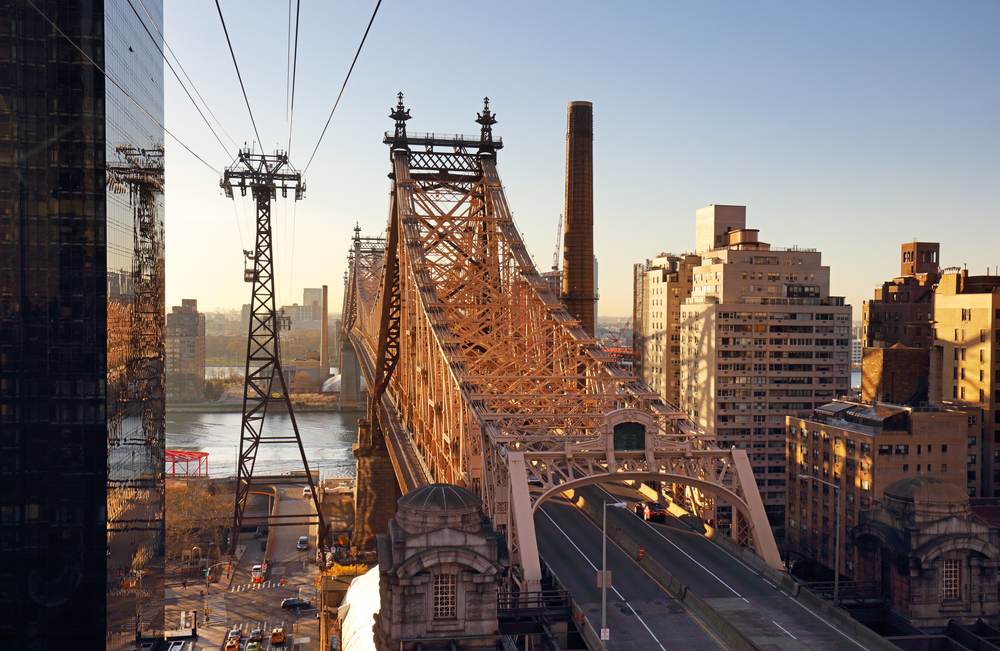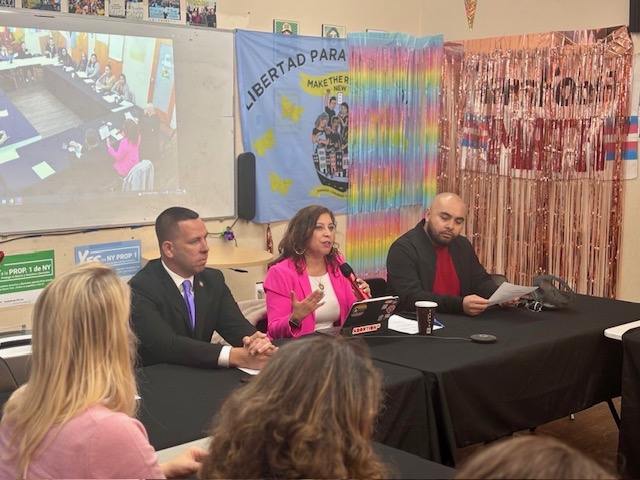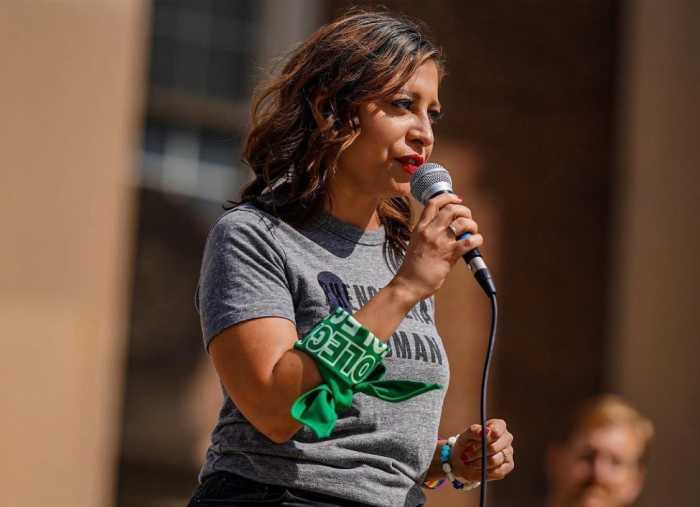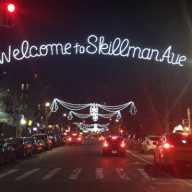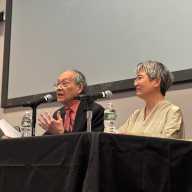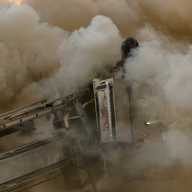Elected officials and local leaders across Queens expressed mixed reactions to Gov. Kathy Hochul’s decision to bring back congestion pricing for motorists entering Manhattan below 60th street.
Hochul announced Thursday that the toll, which is now set to go into effect in January, will be reduced to a $9 peak fee for cars, down 40% from the $15 toll initially proposed before Hochul paused congestion pricing in June. Rates are also set to be reduced across the board by 40%, including for small and large trucks, while there will be discounts for overnight trips into the central business district, and per-ride surcharges on taxi, Uber, and Lyft rides.
A number of elected officials and Queens civic groups welcomed the return of congestion pricing, stating that the measure would bring about improved public transport and cleaner air in New York City. Those in favor of congestion pricing also noted that it would also help plug a hole in the MTA budget.
However, others criticized Hochul over the move to reinstate congestion pricing, including Council Member Robert Holden, who accused the governor of betraying the people of New York. Holden also accused Hochul, a Democrat, of delaying the decision on congestion pricing until after the election for political reasons.
“Gov. Hochul’s move to pause congestion pricing before the election to help her party win, knowing it’s unpopular, only to reinstate it afterward when her party lost, is a blatant political move and a shameless betrayal of New Yorkers,” Holden said in a statement. “This brazen arrogance is why trust in government is at an all-time low. The congestion scam tax is a direct assault on all New Yorkers, and voters will remember this at election time. She will get voted out in 2026 for this betrayal.”
Laura Rothrock, president of Long Island City Partnership (LICP), expressed concerns about the impact that congestion pricing could have on local business in Long Island City, stating that many local businesses rely on trucks for daily operations and could face a steep rise in costs as a result of the measure.
Rothrock also said Long Island City is facing projected traffic increases and a rise in parking demand as a result of the toll because the neighborhood is the last in Queens before the toll is levied. She is concerned that it could prompt a rise in congestion and parking demand as motorists leave their cars in LIC and take public transport into Manhattan.
She said LICP is seeking to ensure that Long Island City remains accessible for businesses, residents and visitors alike and that the proposed toll does not compound existing congestion problems in the neighborhood.
“Congestion pricing must be implemented thoughtfully to avoid unintended burdens on our local businesses. Small manufacturers, wholesalers, and delivery services—many of which rely on trucks for daily operations—could face steep costs, affecting their ability to serve customers and sustain their operations,” Rothrock said in a statement.
On the other hand, Assembly Member Jessica González-Rojas welcomed the announcement, stating that the toll will “help close the funding gap” in the MTA’s capital plan, which aims to keep New York City Transit in a state of good repair.
“As a straphanger and someone who relies on public transit to get around the city, I understand the frustration my neighbors feel about long wait times, inconsistent buses and frequent breakdowns,” González-Rojas said in a statement.
González-Rojas said congestion pricing would help improve New York’s air quality and street safety while also bringing “much-needed improvements” to the city’s public transportation infrastructure.
She also said congestion pricing did not aim to penalize motorists, noting that Hochul had lowered the toll in response to motorists’ concerns.
“We need the strongest possible plan and the lower toll is in response to drivers’ concerns,” she added. “Congestion pricing isn’t about penalizing anyone – it’s about modernizing our transportation system and tackling climate change. I’m relieved to see this crucial initiative moving forward.”
Anatole Ashraf, chair of Community Board 2 in western Queens, also welcomed Hochul’s announcement, stating that congestion pricing would help provide more frequent subways and buses throughout New York City as well as providing elevators at subway stations across the city.
“Many of us on Queens CB2 are thrilled that Governor Hochul will resume the much-anticipated congestion relief plan after advocacy and support from our community district,” Ashraf said in a statement. “The funding will help to upgrade transit options and improve accessibility for riders throughout Queens and encourage more reliance on greener public transit alternatives.”
Ashraf said most New York City residents take some form of public transportation, including the majority of residents who live within the confines of the Community Board 2 district. Like González-Rojas, Ashraf believes the toll will help improve air quality in the city by reducing emissions. He also believes the toll will reduce congestion for drivers in New York’s Central Business District.
“There was no Plan B for this funding to come through, and the congestion relief plan gives us our own mechanism in New York State,” he continued. “As always, I am proud to be a New Yorker and I am confident our State and City leaders will continue to deliver on policies that work for the vast majority of working people.”
City Council Speaker Adrienne Adams, representing the 28th Council District including parts of Jamaica, did not expressly say whether she was in favor of the revamped program. However, she did say congestion pricing must improve the long-term health of the city’s transportation infrastructure.
“New York’s public transportation system is the lifeblood of our city, and millions of riders rely on it to fulfill their basic obligations and seek opportunity. Affordability for New Yorkers must guide our decisions and be a priority we all share,” Adams said. “As implementation of this revised congestion plan advances, investments in the immediate and long-term health of our transportation infrastructure are critical to the well-being of our city and its communities.”
Adams added that revenue generated by congestion pricing must address long-standing injustices in New York City, including for residents in transit deserts in outer-borough neighborhoods and people living in environmental justice communities.
Addressing these longstanding inequities, and meeting the transportation needs of New Yorkers in every part of our city, must be a continued focus for all levels of government.”
Adams said it is critical that the city becomes more affordable and accessible as the congestion pricing plan moves forward, adding that all stakeholders must do everything in their power to ensure that New Yorkers can sufficiently meet living requirements.
Announcing the return of congestion pricing Thursday, Hochul said the reduced tolls are still estimated to raise the required $15 billion from the bond market to pay for capital improvements to the MTA system. Congestion pricing had been earmarked to cover a number of measures included in the MTA’s 2020-24 capital plan, including extending the Second Avenue Subway, replacing ancient subway signals, rolling out new railcars and improving accessibility in the subway system with elevators and ramps.
The Governor has also instructed the MTA to improve bus frequency on 23 routes in the outer boroughs, which was not included in the original plan.
“I believe no New Yorker should have to pay a penny more than is necessary to achieve these goals, and $15 was just too much,” Hochul said Thursday. “We have found a path to fund the MTA, reduce congestion, and keep millions of dollars in the pockets of our commuters.”
The revised proposal will see large trucks pay a peak toll of $21.60 instead of the $36 initially proposed, while cars will now pay an overnight toll of $2.25 instead of $3.75. Meanwhile, the surcharge for taxis has been reduced from $1.25 to 75 cents, while surcharges for ride-sharing apps such as Uber and Lyft have been reduced from $2.50 to $1.50.
The peak toll for motorists will not rise above $9 before 2027 and will not rise above $12 before 2030.

